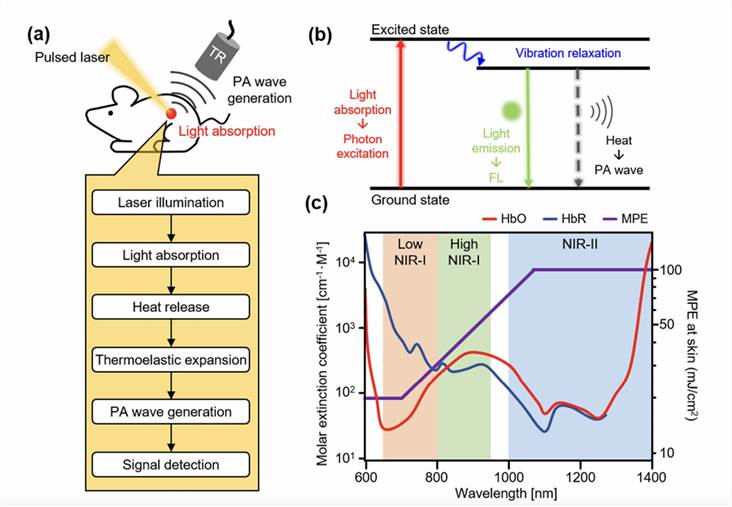Photoacoustic Tumor Imaging Service
As a world-leading service provider for tumor imaging analysis, Creative Biolabs has successfully established a panel of state-of-the-art technologies for exploiting more efficient disease therapeutic regimens. To date, photoacoustic imaging has been widely used as a powerful tool for the diagnosis of malignancies. Now, we are happy to introduce our photoacoustic imaging services for revealing the real-time changes of the whole tumor cell fate.
Introduction to Photoacoustic Imaging Technology
In recent years, due to the shortcomings of existing molecular imaging techniques, such as the low spatial resolution of PET and the radiation risk of CT, photoacoustic imaging, which has the advantages of both optical and acoustic imaging, has gradually attracted attention.
As a new non-invasive and radiation-free biomedical imaging technology, Creative Biolabs photoacoustic imaging technology platform combines the high spatial resolution of ultrasound imaging with the high contrast of optical imaging. It has strong tissue penetration and real-time molecular imaging, which has good clinical application prospects.
In our labs, a variety of tumor samples will receive pulsed light processing to generate specific acoustic signals, which are eventually sent out in the form of sound waves to be received by the device, thus enabling data collection, processing, and analysis. The whole process can be divided into three steps: light absorption, photothermal conversion, and thermoacoustic conversion.
 Fig.1 Schematic Illustration of Principles of PA Wave Generation and Signal Generation.1
Fig.1 Schematic Illustration of Principles of PA Wave Generation and Signal Generation.1
Photoacoustic Agents Services
In the past decade, we have established a large library of contrast agents, providing a wide variety of products, and are constantly developing new types of contrast agents to adapt to different specific scenarios of tumor imaging analysis.
Our endogenous agent is a kind of substance from the animal body that originally has a photoacoustic signal, such as hemoglobin, myoglobin, lipids, melanin, or encoded fluorescent protein. These agents have the advantages of high safety and compatibility. Our exogenous agents are a class of photoacoustic signal substances from external sources, like metal nanomaterials, transition metal chalcogenides, carbon nanomaterials, polymer nanomaterials, organic dyes, and organic nanoparticles. These agents have a better specificity and signal-to-noise ratio, but also potential toxicity and are prone to light bleaching and other shortcomings. As a result, we have been committed to the development of novel photoacoustic agents, trying to provide safer, high-resolution photoacoustic imaging analysis solutions.
 Fig.2 Label-Free Lipid Imaging by PAM.2
Fig.2 Label-Free Lipid Imaging by PAM.2
Cheif Services
Currently, we provide photoacoustic imaging services for the early diagnosis of cancer, the study of tumor angiogenesis, the detection of tumor microenvironment, as well as the monitoring of cancer progression and treatment response. Among them, we have also generated the photoacoustic microscopy (PAM) analysis system, which can achieve high-resolution label-free microscopic imaging at the micron or even submicron scale, for tumor diagnosis. In a recent study, our scientists have used PAM technology to detect melanoma and its surrounding blood vessels, opening up the possibility of understanding the interaction between tumors and their microenvironment, as well as non-invasive detection and staging of melanoma. Furthermore, we use the vascular morphology quantification algorithm to extract the diameter, density, tortuosity, and other multi-parameter information of tumor blood vessels with high precision, which can provide effective quantitative indicators for tumor diagnosis and monitoring.
Features
-
Cutting-edge tumor imaging technology
-
Analysis of difficult tumor images and reports
-
Diverse technology availability
-
Participate in the preclinical translation of research results
-
Affordable cost
With the help of abundant experience and professional scientists, Creative Biolabs is committed to guiding global customers to a series of photoacoustic tumor imaging solutions. If you are interested in our services, please feel free to contact us or directly send us an inquiry.
References
-
Han, S., et al. Contrast agents for photoacoustic imaging: a review focusing on the wavelength range. Biosensors. 2022, 12(8): 594.
-
Tsang, V. T., et al. A review of endogenous and exogenous contrast agents used in photoacoustic tomography with different sensing configurations. Sensors. 2020, 120(19): 5595.
For Research Use Only | Not For Clinical Use


 Fig.1 Schematic Illustration of Principles of PA Wave Generation and Signal Generation.1
Fig.1 Schematic Illustration of Principles of PA Wave Generation and Signal Generation.1
 Fig.2 Label-Free Lipid Imaging by PAM.2
Fig.2 Label-Free Lipid Imaging by PAM.2
 Download our brochure
Download our brochure

